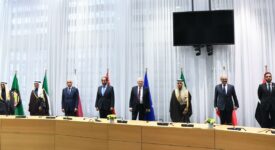Zygmunt Bauman, a renowned Polish sociologist that passed away in January this year, developed a theory of “liquid modernity”, which depicts a situation of constant change, fragility, and vulnerability. Although he originally applied these terms to the labor market, the community and the individual, they could also be readily used to describe and understand the regional order in the Middle East, its institutions, and leading actors.
According to Bauman, social structures that underpin individuals’ behavior fall apart at a faster pace than the new structures before they are able to form. There is no time for long-term planning or for developing a consistent strategy. Each such change presents a set of opportunities and threats but the main fear is the one of missing the train. Something similar is going on in the Middle East right now.
The solid structures of the pre-Arab Spring era have been replaced by a liquid system that has not managed to solidify yet. The liquid has taken over but not replaced the old structures completely yet. To understand why some players in the region keep on sticking to the solid blocs, it is useful to analyze regional conflicts such as Syria, Yemen and Libya but also scrutinize the role of China and Turkey in the region on the one side and that of Egypt and Saudi Arabia on the other. The new administration in the White House has yet to reveal whether it will solidify traditional alliances or lean towards liquidity.
When it comes to Europe, the EU has never been a primary player in the region. Not only because the EU member states are faced with other challenges but mostly because the bloc’s brand in the region has never been about being a strategic ally. To the Maghreb countries, the EU has traditionally been about free trade, a driver of reform and an actor in humanitarian and development areas. In the Maghreb, which has generally played a peripheral role in the region’s large geopolitical shifts, the solid once again coexists with the liquid. Solid is the Algiers-Rabat rivalry and also the Moroccan alignment with the positions of the Gulf Cooperation Council and particularly Saudi Arabia. In contrast, Algeria has gone liquid to become a pivotal actor, a potential mediator and an indispensable interlocutor.
The solid structures in the Middle East thus remain to coexist with old alliances and rivalries. Permanent structures are yet to emerge while old enemies work now together and future allies face each other across various frontlines. The behavior of some regional powers is therefore often being unpredictable, although poised to lead to solid blocs. Yet, distrust still reigns and with it comes risk of sudden changes and defensive reactions and overreactions.
‘Liquid Alliances in the Middle East’ – Analysis by Eduard Soler i Lecha – Barcelona Centre for International Affairs (CIDOB).
(The Analysis can be downloaded here)







